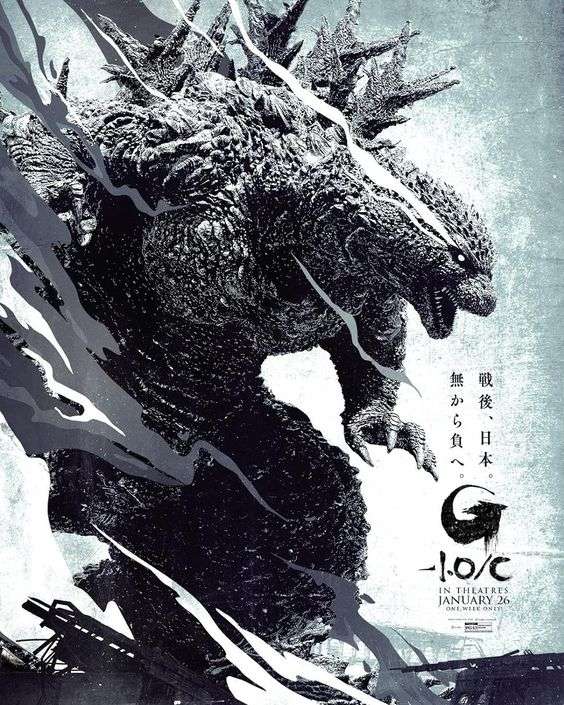We’ve had some issues with emails going to hotmail, outlook and related addresses. If you’ve recently made a purchase using one of these and not received a confirmation email, please get in contact with us – use an alterative email address for contact or purchase if you can.

For all things fantasy, horror, and speculative fiction
Announcement:

Godzilla Minus One
Godzilla Minus One written and directed by Takashi Yamazaki
Starring: Ryunosuke Kamiki, Minami Hamabe, Yuki Yamada, Munetaka Aoki
Reviewed by Matthew Palmer

In the final days of WWII, kamikaze pilot Kōichi Shikishima abandons his mission, setting his plane down at the Oda Island navy outpost, claiming mechanical failure. That night, the outpost is attacked by a giant monster known to the natives as Godzilla. Paralysed by fear, Shikishima fails to act when he can, and the outpost is wiped out, leaving him one of the only survivors of the horrific attack. With the war over, he returns in disgrace to a Japan ravaged by war. There, he builds a life with the drifter Noriko and the war orphan Akiko. Desperate for work, he is employed as a minesweeper, disarming the ordinance that litters the seas around Tokyo. As such, he is on the front lines when Godzilla re-emerges, this time with its sights set on the mainland of Japan. He, his adopted family and his crew must survive the devastation of the creature’s rampages, eventually becoming the heart of a desperate plan to slay the creature and save the people of Tokyo from annihilation.
Of all of the pop culture franchises in Science Fiction, Godzilla is the one I am least familiar with; my only previous experiences are via the Blue Öyster Cult and the risible 1998 Holywood version. The glowing positive reviews of Godzilla Minus One piqued my curiosity, and I was pleased to see it get a much wider cinematic release than would be normal for a film in a foreign language genre. A retelling of the emergence of Godzilla in post-war Japan, this was the perfect place to start for a newbie to the franchise, but I am certain that there is plenty here for experienced fans of the Tokusatsu genre of Japanese filmmaking. As is well documented, Godzilla is never just a giant monster, though, and while the spectre of the nuclear bomb hangs over the film, here, the giant monster serves as a metaphor for survivor’s guilt and post-traumatic stress. Shikishima, played by a raw and expressive Ryunosuke Kamiki, is haunted by the spectre of his experiences in the war, which dominate his life, holding him back from connecting with Noriko and the tiny and adorable Akiko. It is only through confronting the city-destroying monster that he can overcome that trauma and finally end his war.
I know through my other experiences with Japanese pop culture that portrayals of Japanese imperialism can be problematic to outright revisionists. This movie makes no bones about where it stands on that particular spectrum, with the mastermind behind the plan to defeat Godzilla loudly condemning the tactic of throwing away lives without purpose and choosing to fight to preserve life and build a future for everybody instead. In the end, it is the people of Japan banding together to defeat the rampaging monster that saves the day, and it is forgiveness, hope and the bonds between people that eventually save Shikishima from his trauma.
While the heart of the story is a very human one about survival and the bonds that tie us together, those who watch for the spectacle of a creature that can pitch warships several miles through the sky and breathe nuclear fire from its mouth will not be disappointed. From a tense nautical chase in a ramshackle wooden minesweeper, the battle between Godzilla and a Japanese WWII battleship and, of course, the wholesale destruction of a city district, the set pieces that you would expect from a giant monster movie are all here in a spectacular fashion. The effects of the movie are expertly deployed and used with confidence, with most of the action occurring in the full light of day, making sure that we can see Godzilla and the devastation that he causes in all of its glory. There is also a special treat for military history experts, with a version of a real-life experimental fighter plane that was in development by the Japanese at the end of the war playing a key part in the final confrontation.
Of course, no movie is without its flaws. There are a couple of contrivances that stretch believability even if they move the character’s journey along. The presence of female characters in the story is very limited and traditional, and the period setting is no real excuse for that. The excellent and self-possessed Noriko, portrayed by the charismatic Minami Hamabe, could definitely have done with a bit more screen time. With that in mind, it was an excellent first experience with the franchise. It was all the better for having the opportunity to view it on the big screen, and I would urge anyone who is similarly curious to experience one of the oldest and most influential Sci-Fi franchises of all time not to miss the opportunity to do so as well.